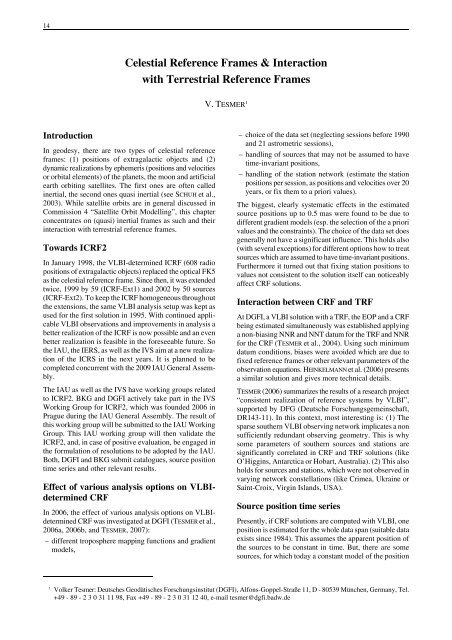NATIONAL REPORT OF THE FEDERAL REPUBLIC OF ... - IAG Office
NATIONAL REPORT OF THE FEDERAL REPUBLIC OF ... - IAG Office
NATIONAL REPORT OF THE FEDERAL REPUBLIC OF ... - IAG Office
Create successful ePaper yourself
Turn your PDF publications into a flip-book with our unique Google optimized e-Paper software.
14<br />
Introduction<br />
Celestial Reference Frames & Interaction<br />
with Terrestrial Reference Frames<br />
In geodesy, there are two types of celestial reference<br />
frames: (1) positions of extragalactic objects and (2)<br />
dynamic realizations by ephemeris (positions and velocities<br />
or orbital elements) of the planets, the moon and artificial<br />
earth orbiting satellites. The first ones are often called<br />
inertial, the second ones quasi inertial (see SCHUH et al.,<br />
2003). While satellite orbits are in general discussed in<br />
Commission 4 “Satellite Orbit Modelling”, this chapter<br />
concentrates on (quasi) inertial frames as such and their<br />
interaction with terrestrial reference frames.<br />
Towards ICRF2<br />
In January 1998, the VLBI-determined ICRF (608 radio<br />
positions of extragalactic objects) replaced the optical FK5<br />
as the celestial reference frame. Since then, it was extended<br />
twice, 1999 by 59 (ICRF-Ext1) and 2002 by 50 sources<br />
(ICRF-Ext2). To keep the ICRF homogeneous throughout<br />
the extensions, the same VLBI analysis setup was kept as<br />
used for the first solution in 1995. With continued applicable<br />
VLBI observations and improvements in analysis a<br />
better realization of the ICRF is now possible and an even<br />
better realization is feasible in the foreseeable future. So<br />
the IAU, the IERS, as well as the IVS aim at a new realization<br />
of the ICRS in the next years. It is planned to be<br />
completed concurrent with the 2009 IAU General Assembly.<br />
The IAU as well as the IVS have working groups related<br />
to ICRF2. BKG and DGFI actively take part in the IVS<br />
Working Group for ICRF2, which was founded 2006 in<br />
Prague during the IAU General Assembly. The result of<br />
this working group will be submitted to the IAU Working<br />
Group. This IAU working group will then validate the<br />
ICRF2, and, in case of positive evaluation, be engaged in<br />
the formulation of resolutions to be adopted by the IAU.<br />
Both, DGFI and BKG submit catalogues, source position<br />
time series and other relevant results.<br />
Effect of various analysis options on VLBIdetermined<br />
CRF<br />
In 2006, the effect of various analysis options on VLBIdetermined<br />
CRF was investigated at DGFI (TESMER et al.,<br />
2006a, 2006b, and TESMER, 2007):<br />
– different troposphere mapping functions and gradient<br />
models,<br />
V. TESMER 1<br />
– choice of the data set (neglecting sessions before 1990<br />
and 21 astrometric sessions),<br />
– handling of sources that may not be assumed to have<br />
time-invariant positions,<br />
– handling of the station network (estimate the station<br />
positions per session, as positions and velocities over 20<br />
years, or fix them to a priori values).<br />
The biggest, clearly systematic effects in the estimated<br />
source positions up to 0.5 mas were found to be due to<br />
different gradient models (esp. the selection of the a priori<br />
values and the constraints). The choice of the data set does<br />
generally not have a significant influence. This holds also<br />
(with several exceptions) for different options how to treat<br />
sources which are assumed to have time-invariant positions.<br />
Furthermore it turned out that fixing station positions to<br />
values not consistent to the solution itself can noticeably<br />
affect CRF solutions.<br />
Interaction between CRF and TRF<br />
At DGFI, a VLBI solution with a TRF, the EOP and a CRF<br />
being estimated simultaneously was established applying<br />
a non-biasing NNR and NNT datum for the TRF and NNR<br />
for the CRF (TESMER et al., 2004). Using such minimum<br />
datum conditions, biases were avoided which are due to<br />
fixed reference frames or other relevant parameters of the<br />
observation equations. HEINKELMANN et al. (2006) presents<br />
a similar solution and gives more technical details.<br />
TESMER (2006) summarizes the results of a research project<br />
“consistent realization of reference systems by VLBI”,<br />
supported by DFG (Deutsche Forschungsgemeinschaft,<br />
DR143-11). In this context, most interesting is: (1) The<br />
sparse southern VLBI observing network implicates a non<br />
sufficiently redundant observing geometry. This is why<br />
some parameters of southern sources and stations are<br />
significantly correlated in CRF and TRF solutions (like<br />
O’Higgins, Antarctica or Hobart, Australia). (2) This also<br />
holds for sources and stations, which were not observed in<br />
varying network constellations (like Crimea, Ukraine or<br />
Saint-Croix, Virgin Islands, USA).<br />
Source position time series<br />
Presently, if CRF solutions are computed with VLBI, one<br />
position is estimated for the whole data span (suitable data<br />
exists since 1984). This assumes the apparent position of<br />
the sources to be constant in time. But, there are some<br />
sources, for which today a constant model of the position<br />
1 Volker Tesmer: Deutsches Geodätisches Forschungsinstitut (DGFI), Alfons-Goppel-Straße 11, D - 80539 München, Germany, Tel.<br />
+49 - 89 - 2 3 0 31 11 98, Fax +49 - 89 - 2 3 0 31 12 40, e-mail tesmer@dgfi.badw.de











